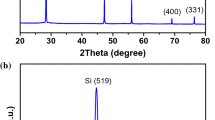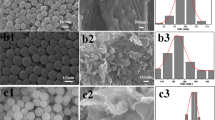Abstract
There have been few reports concerning the hydrothermal synthesis of silicon anode materials. In this manuscript, starting from the very cheap silica sol, we hydrothermally prepared porous silicon nanospheres in an autoclave at 180 °C. As anode materials for lithium-ion batteries (LIBs), the as-prepared nano-silicon anode without any carbon coating delivers a high reversible specific capacity of 2,650 mAh·g−1 at 0.36 A·g−1 and a significant cycling stability of about 950 mAh·g−1 at 3.6 A·g−1 during 500 cycles.

Similar content being viewed by others
References
Su, X.; Wu, Q.L.; Li, J.C.; Xiao, X.C.; Lott, A.; Lu, W.Q.; Sheldon, B. W.; Wu, J. Silicon-based nanomaterials for lithium-ion batteries: A review. Adv. Energy Mater. 2014, 4, 1–23.
McDowell, M. T.; Lee, S. W.; Nix, W. D.; Cui, Y. Understanding the lithiation of silicon and other alloying anodes for lithium-ion batteries. Adv. Mater. 2013, 25, 4966–4985.
McDowell, M. T.; Ryu, I.; Lee, S.; Wang, W. C.; Nix, W. D.; Cui, Y. Studying the kinetics of crystalline silicon nanoparticle lithiation with in situ transmission electron microscopy. Adv. Mater. 2012, 24, 6034–6041.
Szczech, J. R.; Jin, S. Nanostructured silicon for high capacity lithium battery anodes. Energy Envir. Sci. 2011, 4, 56–72.
Armstrong, M. J.; O’Dwyer, C.; Macklin, W. J.; Holmes, J. D. Evaluating the performance of nanostructured materials as lithium-ion battery electrodes. Nano Res. 2014, 7, 1–62.
Li, S.; Li, A.; Zhang, R.; He, Y.; Zhai, Y.; Xu, L. Hierarchical porous metal ferrite ball-in-ball hollow spheres: General synthesis, formation mechanism, and high performance as anode materials for Li-ion batteries. Nano Res. 2014, 7, 1116–1127.
Cheng, J.; Che, R.; Liang, C.; Liu, J.; Wang, M.; Xu, J. Hierarchical hollow Li4Ti5O12 urchin-like microspheres with ultra-high specific surface area for high rate lithium ion batteries. Nano Res. 2014, 7, 1043–1053.
Su, D.; Dou, S.; Wang, G. Mesocrystal Co3O4 nanoplatelets as high capacity anode materials for Li-ion batteries. Nano Res. 2014, 7, 794–803.
Nan, C.; Lu, J.; Li, L.; Li, L.; Peng, Q.; Li, Y. Size and shape control of LiFePO4 nanocrystals for better lithium ion battery cathode materials. Nano Res. 2013, 6, 469–477.
Wu, H.; Chan, G.; Choi, J. W.; Ryu, I.; Yao, Y.; McDowell, M. T.; Lee, S. W.; Jackson, A.; Yang, Y.; Hu, L.; Cui, Y. Stable cycling of double-walled silicon nanotube battery anodes through solid-electrolyte interphase control. Nat. Nanotechnol. 2012, 7, 310–315.
Yoo, J. K.; Kim, J.; Jung, Y. S.; Kang, K. Scalable fabrication of silicon nanotubes and their application to energy storage. Adv. Mater. 2012, 24, 5452–5456.
Jia, H.; Gao, P.; Yang, J.; Wang, J.; Nuli, Y.; Yang, Z. Novel three-dimensional mesoporous silicon for high power lithium-ion battery anode material. Adv. Energy Mater. 2011, 1, 1036–1039.
Xing, A.; Zhang, J.; Bao, Z. H.; Mei, Y. F.; Gordin, A. S.; Sandhage, K. H. A magnesiothermic reaction process for the scalable production of mesoporous silicon for rechargeable lithium batteries. Chem. Commun. 2013, 49, 6743–6745.
Lee, J. -I.; Lee, K. T.; Cho, J.; Kim, J.; Choi, N.-S.; Park, S. Chemical-assisted thermal disproportionation of porous silicon monoxide into silicon-based multicomponent systems. Angew. Chem. Int. Ed. 2012, 51, 2767–2771.
Yi, R.; Dai, F.; Gordin, M. L.; Chen, S.; Wang, D. Micro-sized Si-C composite with interconnected nanoscale building blocks as high-performance anodes for practical application in lithium-ion batteries. Adv. Energy Mater. 2013, 3, 295–300.
Chen, S. Q.; Bao, P. T.; Huang, X. D.; Sun, B.; Wang, G. X. Hierarchical 3D mesoporous silicon@graphene nanoarchitectures for lithium ion batteries with superior performance. Nano Res. 2014, 7, 85–94.
Kim, H.; Seo, M.; Park, M. H.; Cho, J. A critical size of silicon nano-anodes for lithium rechargeable batteries. Angew. Chem. Int. Ed. 2010, 49, 2146–2149.
Ma, H.; Cheng, F. Y.; Chen, J.; Zhao, J. Z.; Li, C. S.; Tao, Z. L.; Liang, J. Nest-like silicon nanospheres for high-capacity lithium storage. Adv. Mater. 2007, 19, 4067–4070.
Chan, C. K.; Patel, R. N.; O’Connell, M. J.; Korgel, B. A.; Cui, Y. Solution-grown silicon nanowires for lithium-ion battery anodes. ACS Nano 2010, 4, 1443–1450.
Dai, F.; Yi R.; Gordin, M. L.; Chen, S.; Wang, D. Amorphous Si/SiOx/SiO2 nanocomposites via facile scalable synthesis as anode materials for Li-ion batteries with long cycling life. RSC Adv. 2012, 2, 12710–12713.
Zhong, Y.; Peng, F.; Bao, F.; Wang, S.; Ji, X.; Yang, L.; Su, Y.; Lee, S.-T.; He, Y. Large-scale aqueous synthesis of fluorescent and biocompatible silicon nanoparticles and their use as highly photostable biological probes. J. Am. Chem. Soc. 2013, 135, 8350–8356.
Park, N. M.; Choi, C. J. Growth of silicon nanowires in aqueous solution under atmospheric pressure. Nano Res. 2014, 7, 898–902.
Liang, J. W.; Wei, D. H.; Lin, N.; Zhu, Y. C.; Li, X. N.; Zhang, J. J.; Fan, L.; Qian, Y. T. Low temperature chemical reduction of fusional sodium metasilicate nonahydrate into a honeycomb porous silicon nanostructure. Chem. Commun. 2014, 50, 6856–6859.
Alexander, M. R.; Short, R. D.; Jones, F. R.; Michaeli, W.; Blomfield, C. J. A study of HMDSO/O2 plasma deposits using a high-sensitivity and -energy resolution XPS instrument: curve fitting of the Si 2p core level. ACS Appl. Surf. Sci. 1999, 137, 179–183.
Di Vona, M. L., Rosnati, V. Zinc-promoted reactions. Mechanism of the clemmensen reaction reduction of benzophenone in glacial acetic acid. J. Org. Chem. 1991, 56, 4269–4273.
Zhou, Y.; Jiang, X.; Chen, L.; Yue, J.; Xu, H.; Yang, J.; Qian, Y. Novel mesoporous silicon nanorod as an anode material for lithium ion batteries. Electrochim. Acta 2014, 127, 252–258.
Yen, Y.; Chao, S.; Wu, H.; Wu, N. Study on solid-electrolyte-interphase of Si and C-coated Si electrodes in lithium cells. J. Electrochem. Soc. 2009, 156, A95–A102.
Li, J.; Dahn, J. R.; An in situ X-ray diffraction study of the reaction of Li with crystalline S. J. Electrochem. Soc. 2007, 154, A156–A161.
Chan, C. K.; Peng, H.; Liu, G.; McIlwrath, K.; Zhang, X.; Huggins, R. A.; Cui, Y. High-performance lithium battery anodes using silicon nanowires. Nat. Nanotechnol. 2008, 3, 31–35.
Maranchi, J. P.; Hepp, A. F.; Kumta, P. N. High capacity, reversible silicon thin-film anodes for lithium-ion batteries. Electrochem. Solid-State Lett. 2003, 6, A198–A201.
Netz, A.; Huggins, R. A.; Weppner, W. The formation and properties of amorphous silicon as negative electrode reactant in lithium systems. J. Power Sources, 2003, 119, 95–100.
Lu, J.; Nan, C.; Li, L.; Peng, Q.; Li, Y. Flexible SnS nanobelts: Facile synthesis, formation mechanism and application in Li-ion batteries. Nano Res. 2013, 6, 55–64.
Song, T.; Han, H.; Choi, H.; Lee, J; Park, H.; Lee, S.; Paek, W; Kim, S; Liu, L; Paik, U. TiO2 nanotube branched tree on a carbon nanofiber nanostructure as an anode for high energy and power lithium ion batteries. Nano Res. 2014, 7, 1–11.
Cho, J. H.; Picraux, S. T. Enhanced lithium ion battery cycling of silicon nanowire anodes by template growth to eliminate silicon underlayer islands. Nano Lett. 2013, 13, 5740–5747.
Wang, B.; Li, X.; Qiu, T.; Luo, B.; Ning, J.; Li, J.; Zhang, X.; Liang, M.; Zhi, L. High volumetric capacity silicon-based lithium battery anodes by nanoscale system engineering. Nano Lett. 2013, 13, 5578–5584.
Wu, H.; Yu, G.; Pan, L.; Mctthew, M. T.; Bao, Z.; Cui, Y.; Stable Li-ion battery anodes by in-situ polymerization of conducting hydrogel to conformally coat silicon nanoparticles. Nat. Commun. 2013, 4, 1943.
Sun, Y.; Hu, X.; Luo, W.; Xia, F.; Huang, Y. Reconstruction of conformal nanoscale MnO on graphene as a high-capacity and long-life anode material for lithium ion batteries. Adv. Funct. Mater. 2013, 23, 2436–2444.
Liang, J.; Wei, D.; Cheng, Q.; Zhu, Y. Li, X.; Zhang, J.; Fan, L.; Qian, Y. Stable cycling of Fe2O3 nanorice as an anode through electrochemical porousness and the solid-electrolyte interphase thermolysis approach. ChemPlusChem 2014, 79, 143–150.
Cho, J. H.; Picraux, S. T. Silicon nanowire degradation and stabilization during lithium cycling by SEI layer formation. Nano Lett. 2014, 14, 3088–3095.
Zhou, X. S.; Cao, A. M.; Wan, L. J.; Guo, Y. G. Spin-coated silicon nanoparticle/graphene electrode as a binder-free anode for high-performance lithium-ion batteries. Nano Res. 2012, 5, 845–853.
Wang, X.; Liu, B.; Hou, X.; Wang, Q.; Li, W.; Chen, D; Shen, G. Ultralong-life and high-rate web-like Li4Ti5O12 anode for high-performance flexible lithium-ion batteries. Nano Res., 2014, 7, 1073–1082.
Sim, S.; Oh, P.; Park, S.; Cho, J. Critical thickness of SiO2 coating Layer on Core@Shell Bulk@Nanowire Si anode materials for li-ion batteries. Adv. Mater. 2013, 25, 4498–4503.
Nara, H.; Yokoshima, T.; Momma, T.; Osaka, T. Highly durable SiOC composite anode prepared by electrodeposition for lithium secondary batteries. Energy Environ. Sci. 2012, 5, 6500–6505.
Author information
Authors and Affiliations
Corresponding authors
Electronic supplementary material
Rights and permissions
About this article
Cite this article
Liang, J., Li, X., Zhu, Y. et al. Hydrothermal synthesis of nano-silicon from a silica sol and its use in lithium ion batteries. Nano Res. 8, 1497–1504 (2015). https://doi.org/10.1007/s12274-014-0633-6
Received:
Revised:
Accepted:
Published:
Issue Date:
DOI: https://doi.org/10.1007/s12274-014-0633-6




